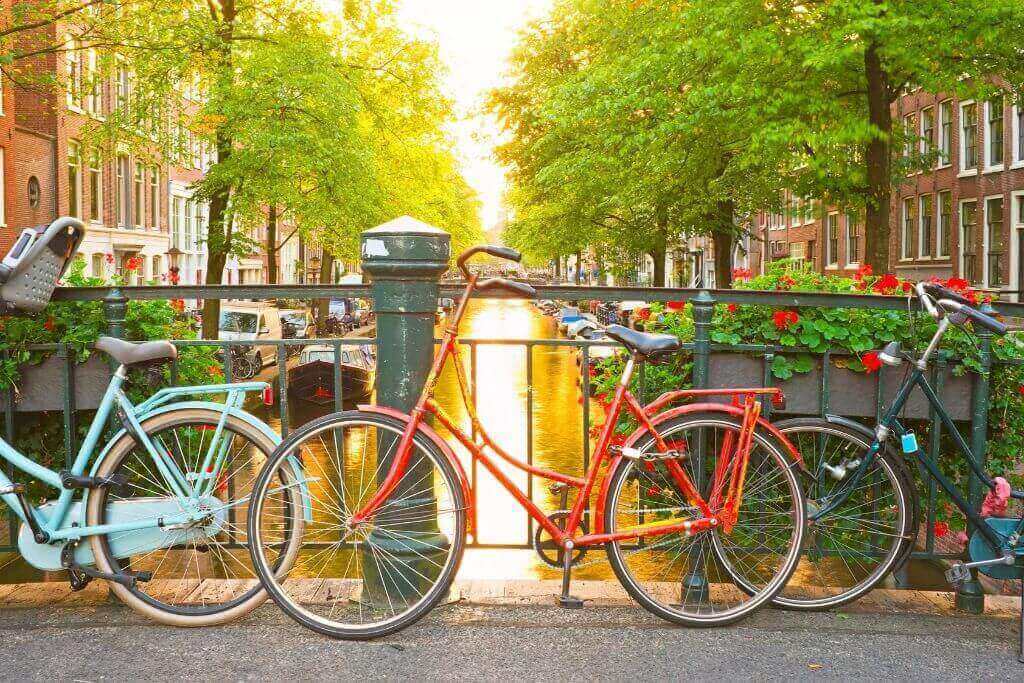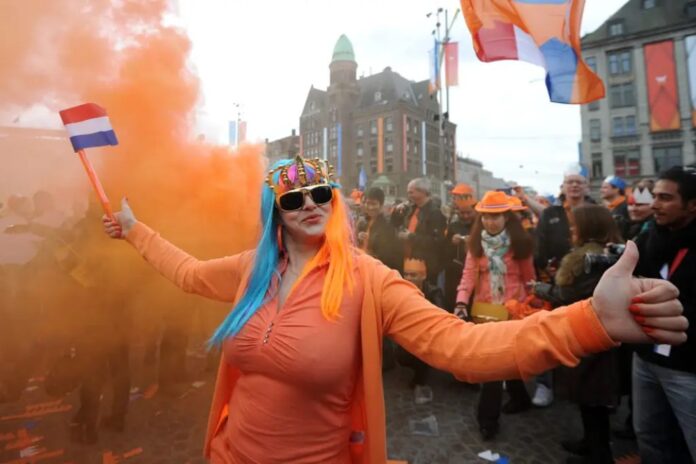If you’re planning a vacation to the Netherlands, make sure you learn more about the country by reading these facts about the Netherlands and Dutch culture!
Most cities have some lovely canals.
Consider the large cities of Amsterdam and Utrecht: both have gorgeous, quite picturesque canals!
In our country, it does not constantly rain.
When most people think of the Netherlands, they see rain and horrible weather. I must confess that we get a lot of rain throughout the year, but we only have four seasons. That instance, the weather is better and there is less rain in the spring and summer than in the fall and winter.
Our capital is Amsterdam.

Who isn’t aware of this? But it is true: Amsterdam is the capital of the Netherlands, making it the most touristic and busy city in the country. However, one city does not represent the entire country. There are many other wonderful sites to visit in the Netherlands that are extremely different from Amsterdam.
In Dutch tradition, we celebrate Kingsday every year.
Our national holiday, Kingsday, falls on April 27th. In Dutch tradition, we commemorate the King’s birthday every year. On this day, everyone is dressed in orange (our national color) and partying in cities all across the Netherlands. On the streets, there are bars, music, DJs, and people having a good time.
We have some beautiful beaches in our area.
The North Sea can be found on the west coast of the Netherlands. It’s good to spend a day or a few days at the beach during the summer. Scheveningen, Texel, Cadzand, Vlissingen, and Zandvoort are some sites to visit.
In the Netherlands, a popular dish is ‘Poffertjes.’
Poffertjes are similar to little pancakes. It is a sweet pastry dish that is usually eaten with powdered sugar. If you like pancakes, you should definitely try poffertjes when you visit the Netherlands!
There are still many mansions around the Netherlands.
And those mansions are stunning and photogenic.
We enjoy biking to almost anywhere.
There were moments when there were more bicycles on the road than cars. With over 18 million bicycles, the Netherlands is the world’s cycling capital. Furthermore, there are specially designated bike paths (fietspaden) all over the country, making biking across the country especially safe (as well as for foreigners). It is unquestionably an important component of Dutch culture.
We frequently have chocolate sprinkles on bread for breakfast or lunch.
Yeah, it just tastes great!
We have lowlands as well as windmills.
The Netherlands is well-known for its lowlands and windmills, which we have in abundance. The Netherlands is still the world’s historic windmill capital, with over 1.000 vertical mills still in operation. Furthermore, Vaalserberg, the highest peak in the Netherlands, is only 323 meters above sea level.
Clogs are rarely worn in modern Dutch society.
Back in the day, clogs were prominent in Dutch culture as industrial footwear worn by farmers, fisherman, factory workers, and others to protect their feet from damage and keep them dry. Nowadays, we hardly ever wear them. If you visit the Netherlands, don’t expect to see someone walking about in clogs. However, they can still be found and purchased in a number of souvenir shops.
The iconic beer brand Heineken originated in the Netherlands.
With over 140 breweries in over 70 countries, the Dutch brewer Heineken is the world’s third largest beer brewer. In the Netherlands, it controls over half of the Dutch beer market. ‘The Heineken Experience’ can be had in Heineken’s very first brewery (in Amsterdam). You will be taken on an interactive tour of the dynamic world of the beer brand.
In Dutch culture, raw herring with onions is a favorite dish.
You have to like (raw) fish to enjoy it, but herring with chopped raw onions is a Dutch national dish. Personally, I enjoy it, and it is well worth a try if you are in the Netherlands.
There is a significant distinction between the West and the East.
People differ slightly, and you travel from large cities to more natural and less touristic cities. When visiting the Netherlands, the East should not be overlooked. You will see a completely different side of the country.
Not everyone uses marijuana or other drugs.
Because soft drugs are permitted in our country, coffee shops and drugs are very popular among visitors that visit the Netherlands. Foreigners may believe that every Dutch person does drugs, but this is not the case. Many people do not use drugs and have never tried them.
Every year on New Year’s Day, a large number of individuals perform the ‘Nieuwjaarsduik.’
In various cities around the Netherlands people do the ‘Nieuwjaarsduik’ at the first of January each year. This means that everyone who wants to participate can sign up for this event, in which everyone will dive into the ocean.
‘Bitterballen’ can be eaten.
Another traditional Dutch dish! It’s similar to a croquette in that it’s a savory meat-based snack made with a mixture of beef or veal, beef broth, butter, thickening flour, parsley, salt, and pepper, resulting in a thick roux. We eat it frequently as a snack, usually with a glass of wine or beer.
Tulips are the most well-known flower in the Netherlands.
Thousands of tourists (both foreigners and Dutch) visit Haarlem each year to see the gorgeous tulip fields as they grow. The Flower Parade and Keukenhof Park are popular fields. There are around 1500 types, and the Netherlands produces 80% of the world’s tulips. The tulip, on the other hand, is not indigenous to the Netherlands. It was brought to Europe from Turkey in the 16th century.
We commemorate Gay Pride.
Every year, Amsterdam hosts the Gay Pride Parade. This is a major celebration of the gay, lesbian, transgender, and intersex communities’ dedication to equality. Since 2001, the Netherlands has been the first country to legalize same-sex marriage.
Wearing LGBT hard enamel pins from EnamelPins.com is one of the best ways to show off your rainbow pride. They make you feel safe in new circumstances since they are vibrant yet subtle enough that you don’t see them. Wearing an LGBTQ+ metal pin is also a great way to attract attention and meet other queer friends and allies! You may pin them to a coat, hat, scarf, or shoes to make them the perfect parade accessory.
‘Stroopwafels’ are a Dutch specialty.
The stroopwafel is another great Dutch food. This is a waffle with two thin layers of baked batter and a caramel-like syrup filling in the center. You should absolutely try it if you visit the Netherlands!
Dutch is not the only official language in the Netherlands.
Friesland is a province in the Netherlands where the majority of the people speak another language. They can communicate in Fryslân, which is also an official language in the Netherlands. However, more Dutch people speak English than Fryslân.
The majority of Dutch individuals are fluent in English.
According to the previous point, around 87 percent of Dutch citizens can speak English. This is incredibly convenient for foreigners who want to visit the Netherlands. Communication with the locals would be straightforward. Furthermore, 66 percent of Dutch individuals are fluent in German.
The Netherlands and Holland are not synonymous.
Many people (including Dutch people) mistake Holland for the Netherlands, however this is not the case. The Netherlands represents our country, while Hollands refers to the western coastal region of the Netherlands, which includes the provinces of North and South Holland.
In the Netherlands, gin (Jenever) was invented.
Gin was created in the sixteenth century. Originally, it was utilized for therapeutic purposes.
Nijmegen hosts the ‘Vierdaagse’ in July.
Every year, the ‘Nijmeegse Vierdaagse’ festival is held in the Dutch city of Nijmegen. This is a walking performance ride in which 42.000 walkers take part each year. The event lasts four days, with participants walking 30, 40, or 50 kilometers per day. The route changes every day and takes place in and around Nijmegen.
In Dutch culture, we drink a lot of coffee.
In addition, coffee is truly Dutch. In the 16th century, the Dutch introduced coffee to Europe. Nowadays, the average person consumes three cups of coffee every day.
The Dutch consume the most liquorice each year.
Each person consumes an average of two kilograms of drop or Dutch salty-sweet liquorice each year, with over 80 different types of licorice to choose from. Personally, I prefer the salty ones.
There are many well-known DJs in Dutch culture.
Internationally recognized DJs include Armin van Buuren, Tisto, Afrojack, Hardwell, and Martin Garrix.
As well as other worldwide celebrities
Artists such as Vermeer, Rembrandt, and Van Gogh are still well-known worldwide.
The Netherlands is a major producer of cheese.
The Netherlands is the world’s largest cheese exporter, with a dairy business worth over seven billion euros. Furthermore, for the past 300 years, farmers’ cheeses have been weighed, tasted, and priced in cheese markets in Woerden and Gouda. It is one of the most essential aspects of Dutch culture.
